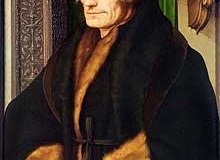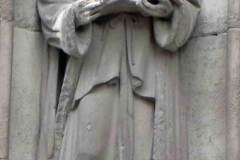(1466-1536) Dutch Priest, Theologian, Humanist & Writer
Desiderius Erasmus was the illegitimate son of a Dutch priest, who rose to fame as the foremost Renaissance scholar of northern Europe. He made four visits to Britain, including one to Canterbury around 1513. He left a fascinating and rather cynical description of the tomb of Thomas Becket in his Latin colloquies (religious discussions). These were published in English in 1536 as The pilgrimage of pure devotion. When the protective wooden cover was raised from the Becket shrine, Erasmus commented that “the cheapest part was gold”. The Canterbury Prior pointed to each jewel in turn with his white rod – “some bigger than a goose egg”. Some have claimed that the suppression of the monasteries by Henry VIII a few years’ later was prompted in part by the implied criticism in the writing of Erasmus.
Many Canterbury students will know his name through the Erasmus programme organised by the European Commission (European Region Action Scheme for the Mobility of University Students) which enables European students to pursue higher education courses in other European countries.
A statue of Erasmus stands on the west end of the cathedral near the west door. Local tradition has it that Erasmus stayed at St Stephens rectory, and that he planted a mulberry tree in its garden. The tree was apparently still there when Cozens wrote his ‘Old Canterbury’ in 1906.
Sources: Brown (1990), Cozens (1906), Nichols (1849) and web site of St Stephen’s church Canterbury


